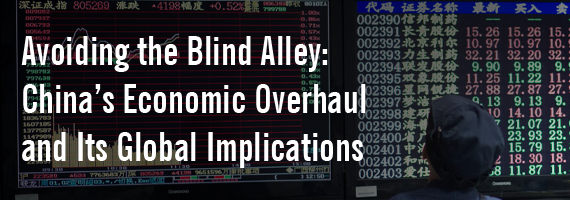Executive Summary: Why China's Growth Model Is Not Working Anymore
In part two of the executive summary, Daniel H. Rosen explains why China’s growth trajectory is flattening — and what new sources of growth could be unlocked by economic reforms. For more on this topic, read Chapter 1 of the full report.
Many of the drivers that contributed to China’s rapid post-1978 growth are weakening, while new sources of growth require reforms yet to be delivered. Demographic dividends propelled China through the 1980s, 1990s, and 2000s, but the labor force is now at its largest and is poised to shrink. Over the past decade, capital formation powered investment-led growth, but finding productive uses for ever greater amounts of debt financing is increasingly difficult for financial incumbents. Existing investments are showing diminishing returns in many overcapacity sectors from steel to coal to property. New industries are hungry for investment, but they are less capital intensive than their predecessors and need an affirmative action program if they are to get the attention of state-owned banks. Total factor productivity gains are fading as the dividends from the last robust round of reforms from World Trade Organization (WTO) implementation dry up.
But China has not exhausted its growth potential. On the contrary, decades more high-quality growth are possible. Massive opportunities exist to upgrade manufacturing to make higher quality products with greater intangible value. Modernization of the agricultural sector holds tremendous potential to benefit the nation and the 100 million citizens likely to remain in farming rather than migrate to new cities. Service industries ranging from advertising to health care to engineering are ripe with potential. And hundreds of millions of middle-class Chinese are eager for investments in environmental clean-up. These growth opportunities depend on regulatory reforms that have been slow in coming but could be enacted more quickly than most people assume.
The external dimension of China’s growth also requires an overhaul. Trade plays a critical role in the economy: China has tremendous comparative advantages to meet global demand and a vast internal appetite for imports of goods and services. Financial globalization has only just begun for China, with cross-border investment flows a tiny fraction of what they would be if Chinese and global savers could move money freely across China’s borders. Foreign direct investment (FDI) in China holds future potential, if parochialism can be avoided. Outbound direct investment is essential if China’s firms are to retain global market share and upgrade capabilities at home. And under any scenario, China will continue to be dependent on globally sourced natural resources even as the foreign policy environment becomes cloudy with geostrategic misgivings.

